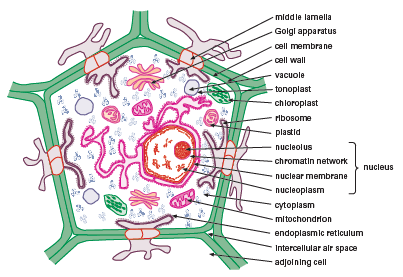Biological Concepts Questions and Answers Grade 10
Share via Whatsapp Join our WhatsApp Group Join our Telegram GroupTopic 7: Questions and Answers
- Answer the questions below.
- Give yourself one hour.
- Check your answers afterwards and do corrections.
Questions
- Draw a diagram of a plant cell with its main components. (8)
- What are the following called? (5)
- Cytoplasmic threads in plant cells.
- The separating wall between two plant cells.
- The jelly-like fluid content in the cell.
- Ribosomes that occur in small groups in the cytoplasm.
- The watery fluid in vacuoles.
- State where plastids occur, give a brief description of the three types and state the function of each. (9)
- What is the function of the cytoplasmic threads? (3)
- Draw a diagram of a plant cell and name all the parts. (20)
- What are the three main functions of cell division in a living organism? (3)
- Describe the process that takes place during the prophase of mitosis. (8)
- What are the differences between meiosis and mitosis? (14)
[Total marks: 70]
Answers
-

-
- Plasmodesmata
- Middle lamella
- Cytoplasm
- Polyribosomes
- Cell sap
-
- Chloroplasts: Occur in all the green parts of a plant: contain chlorophyll, which gives plants their green colour. Photosynthesis takes place in the chloroplasts.
- Chromoplasts: Chromoplasts are responsible for the red, orange and yellow colour of many flowers, fruits and autumn leaves.
- Leucoplasts: Plastids that contain no colour or chlorophyll. They only appear in cells that are not exposed to sunlight, for example the cells in the roots and seeds of plants. The main functions of leucoplasts are to store nutrients (such as starch) and to manufacture oils and some proteins.
- They allow water, glucose and amino acids to pass from one plant cell to another.
-

-
- Repair damaged cells
- Growth
- Reproduction
- Prophase (first phase)
- The cell membrane starts to break down.
- The chromatin network starts changing. The threads become shorter and thicker and are now called chromatids.
- Two chromatids are joined by a centrometre to form a chromosome.
- The nuclear sap changes from a fluid to a gel.
- Larger cell structures, such as the plastids (plant cells) and mitochondria disappear.
- The nucleolus disappears.
- Spindle threads start forming in the cytoplasm.
-
Mitosis
Meiosis
Takes place in somatic cells (cells in the body)
Takes place in the sex cells (gametes)
One division of the mother cell gives two daughter cells, identical to one another and the mother cell
Two divisions of the mother cell give four haploid gametes, each different from one another and the mother cell
Number of chromosomes in the nucleus of mother and daughter cells remain the same
Mother cell has a diploid (2n) number of chromo- somes. The four gametes are all haploid (n). There- fore, the number of chromosomes in the mother cell is halved.
No pairing of homologous chromosomes
During prophase of the first meiotic division, pair-ing of homologous chromosomes takes place
No exchange of DNA (crossing-over) between chro- mosomes
DNA exchange (crossing-over) takes place
Centromeres split during anaphase
Centromeres only split during anaphase of the sec- ond meiotic division (and not during the anaphase of the first meiotic division)
The daughter cells have exactly the same genetic make up as the mother cell
The gametes have different genetic material than the mother cell

